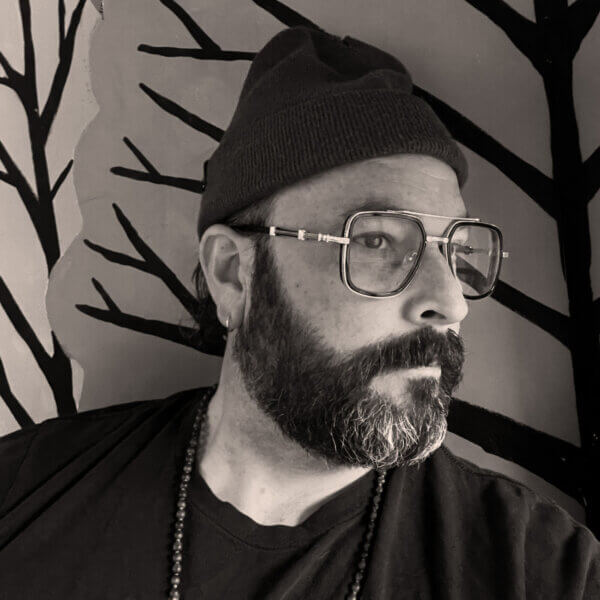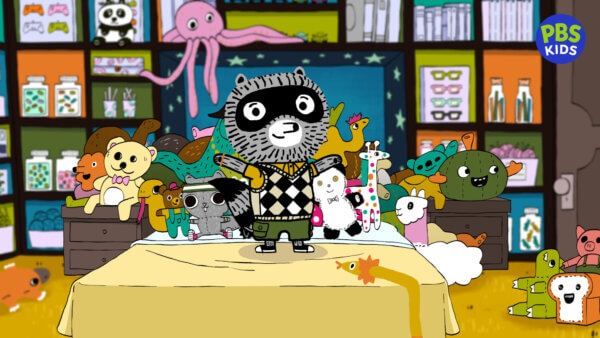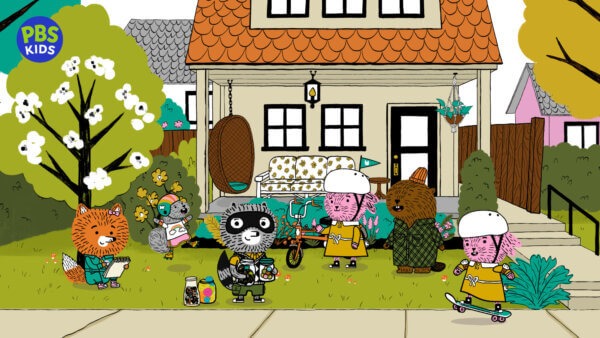Autism Awareness Month: Interview with Zachariah OHora, Creator of Carl the Collector
Our series of interviews for Autism Awareness Month has returned, where I previously had the privilege to speak with talented neurodiverse people who work in the animation industry. From television creators and writers of iconic television shows to popular YouTube animators with millions of viewers to celebrated directors from acclaimed studios, I have been honoured to share the stories of creative and diverse neurodiverse individuals.
For this year’s interview, we were fortunate to be joined by Zachariah OHora, an illustrator and author who created his first animated series for PBS KIDS last year, Carl the Collector. The show follows Carl, a raccoon on the autism spectrum who resides in Fuzzytown with his Mum, as he and his neighbourhood friends get into all kinds of adventures thanks to his many collections of various treasured things. Throughout the interview, Zachariah shared how he created the character, what the reaction has been from domestic audiences, and what it was like to work with a mixture of neurodivergent and neurotypical cast and crew members during the production.
Before creating Carl the Collector, you have been an author and illustrator for several picture books. How did you transition from literature to working in the animation industry?
In a lot of ways, it was an easy transition in that I was kind of doing a lot of the same things with just creating characters and coming up with stories. People who knew what they were doing, were doing the other parts.
At the same time, it’s been about ten years in the making, this show, so all along the way it was about learning how animation works and where’s all the moving parts and what are people’s job titles and all that kind of stuff. In some ways it was a gradual process where I started not understanding a word from anyone of what was said in any meetings to slowly being immersed into “OK, here is the process.” It’s fascinating.
What was the inspiration and journey behind Carl the Collector?
Carl the Collector is a show about a raccoon who is autistic and loves to collect things. I love raccoons and obsessed with woodland, fuzzy creatures and I’m a collector. I collect a lot of stuff including records.
My sons at the time were starting school and I do a fair few school visits with book stuff, but they go to an inclusion school and it was a new concept for me. Basically any student in the district, whatever needs they have they’re covered and they don’t go to a different classroom so everyone’s in the same classroom, wherever they need an aid with them or need extra time out of the classroom or they need different concessions to help them throughout the day. The idea is everyone should have the same access and experience in the classroom, same access to the teacher and obviously the social time with other students.
What I realised for my kids was that anybody who was neurodiverse, my kids just accepted them equally because they were in the classroom at all times and exposure to the full range of humanity and what that meant just normalised everything right out of the gate. I realised it was very different from how I grew up and it was a lot closer to the way things should be. It takes a lot of stigma out of a lot of things and allows people to be themselves and to see each other wherever they’re at. So the idea of ‘if there’s more exposure on a media level of kids who are neurodiverse and whatever’s going on with them from a younger age’ then everyone will accept it and understand it at an early age.
Why did you want to make the protagonist an autistic character?
Partly the answer I just gave to that previous question. It just seemed like something that was missing from the landscape of children’s television and children’s media in general and it seemed obvious as the definition of it has changed. At the time I didn’t know anything about autism and I think that’s the case for most people that are neurotypical unless they have a family member who’s neurodiverse, they don’t understand. It just seemed like it was something that was needed.
The production had such a diverse range of cast and crew members, but it also had several people on the spectrum, including voice actors and consultants. What was it like to collaborate with such a diverse range of talented people?
It was an amazing journey. Like I mentioned, I learnt so much during this process. It was our directive right from the beginning to have as authentic of a show as possible. That is also PBS’s directive; whatever the subject matter is, they want to show it right and for us too. We didn’t want to try and tell someone else’s story.
Storytelling is just better if you’re hearing it from someone who has experienced something and you can tell it’s real and comes from a real place. That’s already a great place for dynamic storytelling and you can immediately emphasise with. It was important that there were neurodiverse people of all levels in the production, particularly neurodiverse writers, so they can tell their stories. A lot of the episodes come right from their own childhood.
The same thing went for the actors. Anybody you see who is neurodiverse on screen, are neurodiverse in real-life. Also, in so many areas of the animation – and even in the advisory part – there were people who are autistic or neurodiverse or have immediate family members who are. It was a very personal project for everybody involved and it was great to collaborate with people and get everybody’s take on what life has been like for them and I think it comes through the show.
PBS Kids seems to have a great variety of autistic characters like AJ from Hero Elementary and Julia from Sesame Street. What makes both Carl and Lotta, the other character in the show who is on the spectrum, stand out from previous representations of autistic people?
I think as there has been a growing awareness of autism, we’ve seen more characters that pop up in different shows and sometimes they’re recurring characters, but there hasn’t really been a show for kids of this age or an animated show where this lead character, this sort of hero of the story, is also autistic. That just seemed a natural progression in storytelling. And on top of that, it is an autism spectrum so you can’t have all aspects of it told in one voice. Not one person can represent all of that.
When we went through testing, that’s how we came up with Lotta and realised, especially with girls who often go undiagnosed, they can mask some of their autism aspects so people may not find out until later or if ever. It’s a very different experience for them and that’s why we decided to have more than one character that was autistic in the show. That was really important so that we could show how life is for different people.
There’s also the character Forest who has ADHD and is also allergic to nuts, which is pretty rough when you’re a squirrel and that’s all your family eats. There are other neurodiverse characters and some side characters we haven’t even explored yet throughout the show, but the main idea was to basically give as many voices as possible to a range of people.
I completely agree with you and one of the things I noticed in the show was showing what it was like to be autistic and experience anxiety. I thought that was handled really well, especially as a lot of kids have gone through that or going through that since lockdown. It stood out to me compared to the other PBS shows.
That is a great point and what I would say is that it is a show that has a lead autistic character and other neurodiverse characters. It’s really a show about kids at this age, they’re just starting school and they’re moving beyond to a bigger world outside of their own family and figuring out stuff that we all have to learn, basic social contract of sharing and if things don’t go your own way how do you deal with it. It’s a universal show about friendship and navigating what it means to be human and work with other people so it’s pretty universal too. Obviously there’s things in mind since the lockdown and how that had an effect on kids and particularly with socialisation and more Internet time. All of that came into play as to things we wanted to explore and address.
How has the series been received by audiences, both domestically and internationally?
I don’t know how many people internationally are watching it as it’s mainly been in the US and Canada, but so far it’s been overwhelmingly positive and people are really connecting with it and really see themselves in it because of the authenticity. And to be honest, I kind of underestimated how emotional people get talking about it. When I’ve been speaking with different groups with PBS and outside PBS, people come up to me and say something like “hey, my kid loves your show and they were diagnosed last year and we didn’t know how to tell them.” The kid watches the show and says “I think I’m like Carl. I might be autistic” And that allows them this window to have this conversation with something where there’s already a baseline of understanding.
I’ve spent a lot of time thinking about how to talk to people who are crying to me. It’s very sweet and very touching but it’s also awkward to stand there while someone is trying to tell you something and they’re crying. It’s very touching and I’m even overwhelmed by that response. It’s very positive. It’s doing what it’s supposed to do.
What’s next for yourself and what can fans expect in the future of Carl the Collector?
I’m always doing book projects so I’ve got a few books coming down the pipeline, but I’m very excited that on March 31st we’re having five new episodes drop and we’re still working on the series so there’s gonna be a lot of new Carl content by the end of 2026.
And in that, we’re introducing other characters. We have a pre-verbal, nonspeaking character that we’re going to get on later in the show and explore some other characters. I’m very excited that there’s a lot of episodes that people haven’t seen yet coming out including a couple of video games too.
Carl the Collector is available to stream on Amazon Prime Video in the UK and PBS Kids in the US.




